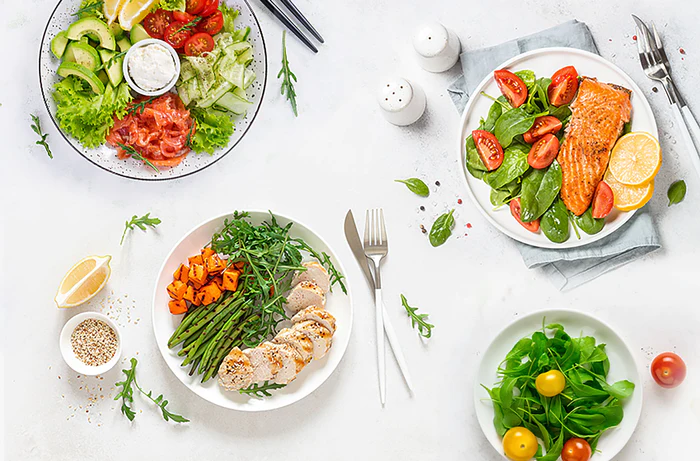In today’s nutritional world of super-foods, magic diets, and dietary villains, everyone seems to be an expert on obesity. In reality, these dietary experts are more like a group of blind men trying to describe an elephant; they are all partially correct in their descriptions of the causes of obesity, but they are all describing a different part of the elephant and aren’t describing the whole picture. Many times, they reach the wrong conclusions about what constitutes a healthy diet.
Describing the Elephant’s Tail
Many secrets we are told are actually myths, or only tell part of the story:
- Calories don’t count – Yes, they do. If you take in more calories than you need at a meal your body has to do something with them, such as store them. This causes oxidative stress especially in the hypothalamus and this disrupts your appetite control center. The bottom line is that you should eat the least number of calories at a meal possible so you aren’t hungry or tired for the next five hours. That’s about 300 calories for a female and no more than 400 calories for a male. The only way to restrict calories this much is to make sure the proteins, carbs and fats are balanced enough to generate the appropriate hormonal responses that suppress appetite.
- Fat is good – It’s true that you need some fat to supply essential fatty acids, but any extra fat that enters into the blood simply reduces the need to release stored excess fat from the adipose tissue needed to provide “high-octane fuel” for the mitochondria to make ATP. Furthermore, a high-fat diet is one that is usually either rich in inflammatory fat consisting of saturated fat (palmitic acid being the worst) or omega-6 fatty acids or both. You need some fat, but most of it should be coming from monounsaturated fat like olive oil, and you still have to use it in moderation.
- Carbs are bad – It is true that there are no essential carbohydrates needed for human nutrition, but it is a different story for the microbes that live in our guts. They require fermentable fiber to survive. If you are not going to supply them enough fermentable fiber to eat, they will start digesting the mucus layer that protects your gut lining since that mucus layer is rich in carbohydrates. This is the first step that leads to a leaky gut. Leaky gut allows food particles to escape the digestive system and enter the blood stream. The body sees these as foreign invaders and mounts an inflammatory response to fight off the invaders. This eventually leads to obesity.
- Insulin makes you fat – Actually, it is insulin resistance that makes you fat. Insulin resistance occurs when the pancreas produces excess insulin because insulin can’t communicate correctly with its target tissues. Insulin resistance is not caused by excess carbs. It is actually caused by excess inflammation. The excess insulin in the blood caused by insulin resistance can make you fat because it increases the uptake of fatty acids into the fat cells and also prevents the release of fat for energy production. This lack of energy production makes you hungry. However, insulin in the brain (the hypothalamus) shuts down hunger. If you have insulin resistance, the ability of the hypothalamus to sense insulin is compromised and you are always hungry. If you eat more calories than you need, you gain weight.
Describing the Heart of the Elephant
There is a different part of the elephant that is not discussed by most experts because it is hard to find. Asking a blind man to describe the heart of an elephant is impossible because he can neither see it nor feel it. It’s not obvious, so it gets overlooked. These things include:
- Endocannabinoids – One of the most common effects of smoking marijuana is increased appetite (i.e. the munchies). This is because the active ingredient in marijuana is THC that can activate endocannabinoid receptors in the brain that make you ravenous. There are other drugs that block those sites and cause weight loss. Unfortunately, their side effects were severe enough to take those drugs off the market. A better way to lower endocannabinoid levels in the brain is to take a lot of fish oil because endocannabinoids are derived from omega-6 fatty acids and high-dose fish oil which contains omega-3s has been shown to reduce endocannabinoid levels.
- Metabolic endotoxemia – When large amounts of bacteria enter the bloodstream it causes sepsis and usually causes death. When small amounts of bacteria enter the bloodstream, it causes inflammation and you get fat. About half the bacteria in your gut carry fragments such as lipopolysaccharide (LPS) that activate toll-like receptors on the surface of your cells. This activation causes cellular inflammation. The more fat you eat (especially saturated or trans fats), the easier it is for the LPS molecules to enter into the bloodstream since they can piggyback on the surface of chylomicrons formed by dietary fat upon absorption from the gut.
- Resolution of inflammation – If it was simply inflammation that makes you fat, then taking anti-inflammatory drugs should make you thin. It doesn’t work that way. You have to resolve inflammation, not simply inhibit it. To accomplish that goal you have to generate large amounts of hormones known as resolvins. These can only be made from EPA and DHA. If you don’t have enough EPA and DHA in your diet, then you will always have excess cellular inflammation and that will make you fat by causing insulin resistance.
- Polyphenols as gene activators – Polyphenols (in therapeutic levels) are powerful activators of anti-oxidative, anti-inflammatory, and anti-aging genes. Without adequate levels of polyphenols in the diet, the genes needed to control weight gain will remain silent. You either have to eat a lot of non-starchy vegetables and fruits to get adequate levels of polyphenols or take a lot of polyphenol supplements to activate these key genes that prevent weight gain.
- Hypothalamic inflammation makes you fat – Obesity actually starts with inflammation in the hypothalamus. Reduce that inflammation in the hypothalamus and you will be less likely to eat excess calories. If you eat fewer calories, you lose weight.
Describing the Trunk of the Elephant
Finally, there are the more well-known parts of the elephant that are exciting enough for experts to focus on and are sometimes made into common dietary villains. These don’t always stand up to science but often become popular and trendy. Just as people think of an elephant’s trunk as the distinguishing feature that makes an elephant stand out from other animals, these dietary villains become trendy because they are easy to describe. They still don’t give the entire picture. These include such concepts as:
- Fructose makes you fat – Excess fructose, like excess calories or an excess of any nutrient, will make you fat. But if you consume adequate levels of polyphenols, even excess fructose has no effect on making you fat because the polyphenols are activating the genes that make you thin. This is why an apple (rich in fructose) a day keeps the doctor away. It’s the polyphenols.
- Gluten makes you fat – Gluten supposedly makes you fat by causing inflammation. That’s only possible if you have a leaky gut so large fragments of any protein can enter into the bloodstream to cause an inflammatory response. If you have an inflamed gut the usual suspects are either metabolic endotoxemia, lack of fermentable fiber, excess inflammatory fat (saturated fats, trans fats, and omega-6 fats), excess calories causing oxidative stress, or all of the above. Work on removing the usual suspects first before declaring gluten to be the “evil one.”
All of these concepts have complex relationships with the diet that are rarely discussed by the experts. Until they are, our obesity epidemic and its consequences, diabetes and Alzheimer’s, will be here to stay. Nutrition is a lot more complicated than we are led to believe and focusing on describing just parts of an elephant doesn’t tell us enough about the entire animal. An elephant can’t work properly without all its parts and neither can nutrition.
How do you eat an elephant? One bite at a time. How do you learn about nutrition? One concept at a time.






Let Us Know What You Thought about this Post.
Put your Comment Below.